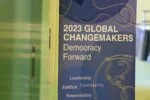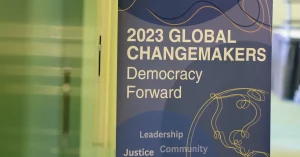HIGHLIGHTS
• Biden’s Big Bucks Revival Plan
• Economic Boom
• Climate Focus
• Migrant Migraine
• Republicans Struggle
• Biden Republicans
Biden’s Big Bucks Revival Plan
At the start of April, Joe Biden unveiled a $ 2 trillion infrastructure plan that would not only mean better roads and bridges but would drastically green the United States energy sector and pour money into future scientific research and development. “In 50 years, people are going to look back and say, this was the moment that America won the future,” he said while announcing the American Jobs Plan. If fully implemented and tax credits and incentives are also included, the plan could lead to spending in the region of $ 4 trillion.
The administration will launch a second spending plan of about $ 1 trillion which will focus on human development. All of this comes on top of an initial relief package that sought to alleviate the economic distress caused by the pandemic.
The scale of Biden’s plans and the changes he is advocating have led to comparisons with previous US presidents like Franklin Delano Roosevelt, author of the New Deal, or Lyndon Baines Johnson, author of the Great Society programmes. He seems to have similar thoughts. Biden invited a number of prominent historians to the White House, including Walter Isaacson and Michael Beschloss, in late March and spent two hours discussing the ways and means of past US leaders noted for their accomplishments. The jobs plan and welfare elements like affordable child care are attracting approval ratings of over 70% plus indicating support among independents and even some Republicans.
While Biden has repeatedly spoken about his desire to re-establish a spirit of bipartisanship in Washington, when it comes to his domestic agenda the president outreach to his Republican opponents has been cursory. This reflects deep anger among the Democratic base at the no-holds-barred ways of the Donald Trump administration and a belief the Republican Party remains beholden to the ex-president. Also, with midterm elections coming next year, Biden may feel uncertain about the future of his legislative majority.
http://go.pardot.com/e/827843/41-405f-a3ac-c31550c590bc-html/lj5fd/207357809?h=Nlcsce2mfz9SB5NoOOI83pkYQG7IEYFKgNafhjpFYvk
http://go.pardot.com/e/827843/ming-of-fdr-and-lbj-utm-source/lj5fg/207357809?h=Nlcsce2mfz9SB5NoOOI83pkYQG7IEYFKgNafhjpFYvk
The $ 2 trillion will be spent over an eight-year period. Half of the amount would be spent on traditional infrastructure such as transport, clean water but also universal broadband. The other half will be climate-related, with an eye to making US electricity production completely green by 2035 and the entire US economy decarbonised by 2050. Electric mobility will be allotted $ 174 billion and public transport $ 165 billion. Subsidies would be used to retrofit buildings for energy efficiency, build power lines to help carry renewable energy, and promote technologies like off-shore wind and carbon capture and storage. The last would receive $ 185 billion. The plan is being described as the “most far-reaching climate bill ever enacted.” Some of the more interesting proposals include a civilian climate corps which would hire former miners and put them to work capping abandoned mines.
Biden’s second spending plan has attracted criticism on expected lines. Republicans, unhappy this will be funded by ending Trump’s corporate tax cuts and unenthusiastic about non-market green energy promotion, have sworn to oppose most if not all of the plan. Progressive Democrats have grumbled the outlay is half the size of the “Green New Deal” promised during the campaign. While Biden has repeatedly said he wishes to work in conjunction with the Republicans it is expected he will have to use the Democrats’ one-vote majority in the Senate to get the bill passed. He will probably also use the budget reconciliation process which, similar to a revenue bill in the Westminister parliamentary system, disallows the opposition from using the filibuster rule and requiring the administration to muster a 60-40 supermajority. Speaker of the House of Representatives Nancy Pelosi has indicated she hopes to get the infrastructure plan passed by early July.
Economic Boom
The sheer size of the spending bills being passed and proposed by the Biden administration, record low interest rates and the US governments steady progress in controlling the spread of Covid-19 cases has led economists to forecast robust growth for the US economy in the coming year. Most forecasts predict 6% growth in 2021 with new jobs accruing at the rate of one million a month. Questions remains as to how many US businesses will go under and the job losses this will entail. So far this seems unlikely with commercial bankruptcies in 2020 actually 15% lower than the year before thanks to generous government support. The figures for 2021 remain unknown. Another concern is a mutation of the virus negating the present successes in vaccinations.
Biden’s plans to increase the corporate tax rate to 28% which, combined with state levies, would mean a combined 32.3% corporate tax for US firms. This would be the highest such tax among the developed countries of the Organization for Economic Cooperation and Development. The tax increase is expected to raise about $ 700 billion a year. Economist Larry Summers has said that the historically low cost of capital would mean most US firms would not be affected by the tax increase.
The Democrats make no secret of their hope the three financial packages will also tilt the electoral landscape in their favour during congressional midterm elections in late 2022. With razor-thin majorities in both houses and a tradition of ruling party seat losses, these elections could spell the end of radical policy-making for the Biden administration. But the more they rush through these large bills, the less likely they will be able to get the necessary votes to pass legislation on immigration and gun reform. The other issue is that, despite its size, many of the elements of the infrastructure package are unlikely to create jobs or generate wealth for a number of years.
The third proposed financial package, with its focus on universal pre-kindergarten, free community college and liberal family leave regulations, will be especially difficult as it will probably require a tax increase on high-income individuals and an unusual expansion of governmental authority, both of which Republicans and even some Democrats will be uncomfortable with. Congressmen already speak of a degree of “spending fatigue” on Capitol Hill.
Nearly half of Americans now believe their economy is on a positive trajectory. While 46% of Americans believe this, it is skewed heavily towards Democrats (58%) compared to 35% among Republicans and 37% among independent voters. The partisan bias is even more pronounced when asked to evaluate the economic relief package passed by the Biden administration with Democrats supporting the measure three times more than Republicans. With only 31% of Americans saying the administration was spending too much, there is clearly public support for a greater economic role for the state. Wall Street also believes a strong economic boom is on the horizon with JP Morgan Chase arguing the billions being laid out by the US will power high rates of global growth until 2023, virus permitting.
Climate Focus
The difficulties expected in building a climate-friendly electric grid serves as an example of how difficult implementation of the Biden plan may become. Experts say this grid will likely take years to lay out because of the many regulatory and legal problems the construction of transmission lines face in the US.
A green energy grid would have to extend to parts of the US where it would make sense to build solar farms or wind turbines but which presently lack transmission. The Competitive Renewable Energy Zones project in Texas successfully built 2300 miles of new lines and led the state to become a frontrunner in wind energy. Much of the present US energy grid is fragmented, highly localised and is designed around fossil fuel power sources. However, building new transmission lines has been extremely difficult in the US. Local communities often campaign against them over health fears or simply because they would ruin scenic views. Most regions of the US have little expertise in long term grid planning, let alone green energy integration. The Federal Energy Regulatory Commission has said it now intend to make transmission planning a policy priority.
The Biden administration plans to commit, say reports, as much as $ 20 billion in climate finance over the next four years to developing countries. The US president has already allotted $ 1.5 billion in his recent budget outlines for the United Nations Green Climate Fund. This is partly compensation for the Trump administration’s freeze on such payments and the overall failure of rich countries to come through on their climate summit pledges of $ 100 billion to help developing countries. The larger commitment will be announced during Biden’s virtual climate summit on April 22-23 and is designed to encourage similar large commitments from other countries. The Green Climate Fund contribution is to complete an earlier US promise, only half completed, to donate $ 3 billion to the fund.
Domestically, Biden is mulling drastically increasing the existing US carbon pledge, laid down by President Barack Obama, of reducing carbon emissions by 26 to 28% by 2025 to a steeper 50% reduction by 2030. He has pledged a more aggressive US climate stance at home to various world leaders. But climate has the least amount of partisan convergence of almost any policy issue in the US Congress with even a few Democrats wary of carbon cuts. Biden will struggle to pass legislation and will need to use executive orders which are easily overturned by any Oval Office resident.
Migrant Migraine
The Biden administration is struggling with the issue of immigration. His comprehensive immigration plan is stuck in the lower house, where it still lacks votes for passage because of resistance from within his own party.
The plan increases the number of employee-sponsored H-1B temporary work visas, the majority of whom are Indians, from 55,000 to 80,000 a year and loosens the country quotas that presently governs H-1Bs. Dependents of H-1B visa holders would also again receive work permits. Biden initially said he would not raise the 15,000 cap on refugees imposed by the Trump administration – a historic low for the US. But under pressure from progressives and evangelical groups he has since agreed to an increase, the number is unspecified but it will be lower than the 62,500 limit he promised during his campaign.
The immigration plan would also provide a gateway for the US’s 11 million undocumented immigrants to become legal. About a half-million are believed to be Indians. Immigrants who have been in the US before January 1 would be allowed to apply for temporary legal status after passing background checks and become eligible for green cards in five years.
On the politically most sensitive migration issue, illegal migration from Central America, Biden has been foundering. The president wants a long-term solution to the problem. This would include providing economic assistance to the migrants’ countries of origin and addressing corruption issues. The new administration has abandoned some of the Trump administration’s responses including disallowing asylum applicants from living in the US until their applications are processed and “building a wall” along the border. But the new government has been slow to put in place an alternative. Critics argue Trump’s policies were working well by end 2020 with a pathway for asylum seekers but strong deterrents against illegal movement. Biden cancelled Trump’s immigration agreements with the Northern Triangle states of El Salvador, Honduras and Guatemala that allowed asylum seekers to file applications in their home countries. But it then negotiated new agreements with two of these countries and Mexico to position 18,000 security personnel along different borders, arguably a less salutary solution.
The numbers of Central American migrants crossing the border has surged. In March, a 171,000 illegal border migrants were apprehended, the highest number since 2006. There has also been a fourfold increase in the number of unaccompanied minors attempting to cross. US Homeland Security Secretary Alejandro Mayorkas admits the situation is “a challenge” but refuted Republican charges the country faces a crisis.
Vice-President Kamala Harris has been placed in charge of finding a solution and has been called the country’s “Border Czar”. The vice-president is reportedly spending hours at the White House Situation Room speaking to experts and studying reports in an attempt to put together a long-term solution. Political analysts say this could help cement Harris’s credentials as a successor to Biden in the White House – or wreck her trajectory given the issue’s high-risk, high-reward nature. Harris has said, “We all know most people like being at home. . . So we have to ask, ‘Why do people leave that?’ And usually they leave because there is a lack of opportunity or it is just not safe. And so my area of focus on the Northern Triangle is to deal with some of those issues.” Immigration is an issue on which Biden gets among his lowest approval ratings, NPR/Marist poll conducted in March gave him only 34% approval on immigration.
Republicans Struggle
Plans by the Republican mainstream leadership to move the party away from Donald Trump’s brand of nativist populism have so far failed. Trump remains extremely popular with the base of the party. And the ex-president remains a loose cannon. At a Republican National Committee meeting at Trump’s new Florida home in early April, Trump went off script to make personal attacks against his vice-president, Mike Pence, and the Republican Senate leader, Mitch McConnell.
The base of the Republican Party remains strongly committed to Trump. About two-thirds of registered Republicans, fuelled by alternative media and social media platforms, continue to believe Biden was illegally made US president. But Trump supporters, about a third of the electorate, are too small to put a Republican back in the White House though they can be crucial in local or congressional elections.
Because the party is unable to broaden its base it has pursued policies designed to limit voting rights for minorities, curb the ability of the Biden administration to regulate swathes of the economy, and ensure legal immunity for religious conservatives and their agenda. This is partly being done through state legislatures, the Georgia state government’s restrictions on voting access being an example, and is expected to also be pursued in the conservative-dominated Supreme Court. This and inaction on other issues, like climate, has led to surprisingly public criticism of the Republicans by one of their long-standing supporters – Big Business. A number of major companies, such as Georgia-based Delta Airlines, have publicly denounced the new voting laws.
A few traditional Republicans continue to seek to free the party from Trump’s grip. The party’s number three official, Liz Cheney, has been among the few who have publicly turned on Trump. The former president has promised to ensure she is unseated from her congressional seat in 2022 but Cheney seems to believe his influence has peaked. Others have been more careful. Indian-origin governor Nikki Halley has said she will not run for the presidency if Trump decides to run again. Pence has begun preparing the ground for a presidential run – so far without Trump’s endorsement. A number of commentators have argued that politicians like Florida Governor Ron DeSantis are more likely contenders, combining Trump’s combativeness and establishment-bashing language with governance skills and traditional conservative policies.
Biden Republicans
Prominent US political pollster Stanley Greenberg has argued that Trump’s single-minded focus on white identity issues and immigration scaremongering has led to the creation of a new political swing group, what he calls the Biden Republicans. These are white Republican voters who are college-educated, suburban and “supportive of diversity.” Turned off by Trump, they shifted their allegiance to Biden, a Democrat they see as centrist, last November but do not see themselves as Democrats.
He says there is a battle within the Republicans mainstream “between Reagan Democrats—who voted for Reagan, came back to vote for Bill Clinton, some voted for Obama—and a whole new set of voters brought in by Trump.” Trump’s supporters and their white nationalist concerns have driven the Biden Republicans into the Democrats’ fold. Besides the affluent suburban college educated Biden Republicans, he says, there are other Biden Republicans who are working class. For these, economic concerns such as a welfare state that addresses globalisation concerns are more important than race. Biden deliberately appealed to both and helped move many into the Democratic ledger. Many of his policies are targeted at these groups.
John Boehner, the Republican House Speaker for five years during the Barack Obama years, released his memoirs. Much of the book describes the process by what he terms as the rightwing’s “crazy caucus” began taking over the party by using media outlets like Fox News or platforms like YouTube to whip up the base and pressure mainstream conservatives like himself to change their stances and give them positions of influence.
………………………………………………………………………………………………
(The views expressed are personal)
………………………………………………………………………………………………

























